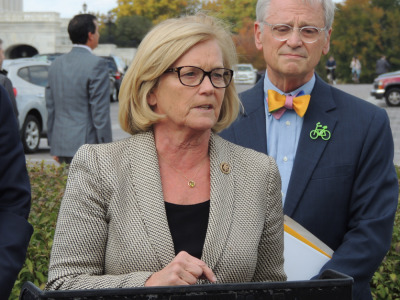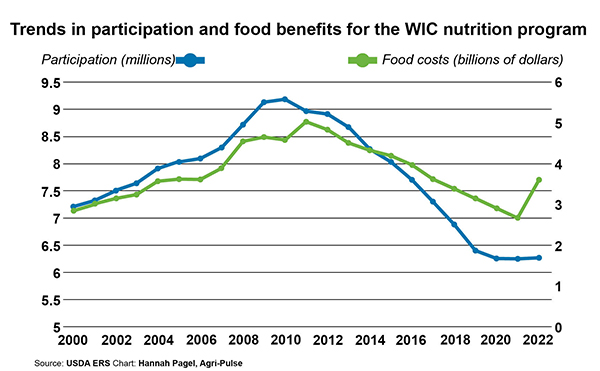House Republicans are trying to roll back an increase in fruit and vegetable benefits for women and kids participating in the WIC nutrition program, which has long had strong bipartisan support.
The House Appropriations Committee approved a fiscal 2024 spending bill for USDA and FDA last week that also would reduce overall funding levels for the Women, Infants and Children nutrition program, potentially creating a waiting list for the program, program supporters claim.
The bill would lower the fruit and vegetable benefit roughly to pre-pandemic levels and fund WIC at $800 million below President Joe Biden's budget request, even as participation in the program is on the rise. House Agriculture Appropriations Subcommittee Chairman Andy Harris, R-Md., said the bill would return WIC benefits "to a normal, sustainable, inflation-adjusted funding level."
During the committee's daylong debate over the spending bill, Rep. Lauren Underwood, D-Ill., attempted to restore the WIC cuts, only to be met by a counterproposal from Harris that would have offset the WIC increase by cutting funding to the popular Rural Energy for America Program.
Underwood withdrew her amendment, so advocates of the fruit and vegetable benefit are counting on the Senate Appropriations Committee to protect the funding when the panel takes up its version of the FY24 Agriculture spending bill on Thursday.
“Whether or not to feed our children should not be a politically charged issue,” said Jamila Taylor, president of the National WIC Association. “It’s just so frustrating that we’re talking about taking the food out of the mouths of children and moms.”
WIC, which is available to pregnant and postpartum mothers as well as children up to age 5, focuses on ensuring children and breastfeeding mothers have the “sophisticated and targeted nutrition” they need during a very specific time, aiming for at least 50% consumption of the required recommendations for fruit and vegetables, Taylor said.
For most foods, WIC provides a specific type and quantity regardless of price, such as a one-pound loaf of whole-grain bread and the ability to purchase needed infant formula, but participants receive a cash value benefit for fruit and vegetables. The House bill reduces the monthly fruit and vegetable benefit from $25 to $11 for 1- to 4-year-olds (a 56% reduction), from $44 to $13 for pregnant and postpartum participants (a 70% reduction), and from $49 to $15 for breastfeeding participants (a 69% reduction).
Rep. Chellie Pingree, D-Maine, pleaded with her colleagues during the House Appropriations Committee debate to preserve the fruit and vegetable benefit. Citing a recent visit to a grocery store, she said a bag of produce made up of an apple, carrots, strawberries, blueberries and asparagus would cost about $14.50.
“So, if you’re getting a benefit of $13 as a pregnant woman, you’ve already had to put something back from your cart,” Pingree said. “This is the level of ridiculousness we have gotten into in this bill for that mother who’s walking down the aisle who no longer is going to have $44 in her pocket; she’s going to have $13. That bag of chips at $1 is looking pretty good.”
 Rep. Chellie Pingree, D-Maine
Rep. Chellie Pingree, D-Maine
The American Rescue Plan enacted in 2021 included $390 million to carry out outreach, innovation and program modernization projects to increase participation and retention in WIC as only half of the people eligible for WIC are enrolled. The pandemic also brought about a renewed focus on the importance of health and good nutrition and an initial 4-month boost in fruit and vegetable benefits in WIC through the ARP to $35 per month for all children and women participants.
Mollie Van Lieu, the International Fresh Produce Association's vice president of nutrition and health, said the increase in fruit and vegetable benefits was intended to increase consumption as well as deal with supply chain issues and was based on 2017 recommendations from the National Academies of Science.
Starting Oct. 1, 2021, monthly cash value benefit amounts were raised to $24 for children 1-4 years old to be consistent with the NAS recommendations to support children receiving half of their recommended intake of fruits and vegetables. The last two appropriations cycles increased the WIC fruit and vegetable cash value benefit.
Don’t miss a beat! It’s easy to sign up for a FREE month of Agri-Pulse news! For the latest on what’s happening in Washington, D.C. and around the country in agriculture, just click here.
Van Lieu said the results were “incredible”; kids ages 1 to 5 were consistently eating two cups per day of fruits and vegetables. Research also found obesity rates were decreasing among 2- to 4-year-olds participating in the program after the food package was updated in 2009 to better align with the 2005 Dietary Guidelines for Americans.
The combination of the higher fruit and vegetable benefits establishing WIC participation as more valuable, higher grocery costs making it harder for low-income families to afford groceries and concerted efforts by policymakers to enroll more eligible families, have likely resulted in participation increasing in recent months, said Zoë Neuberger, a senior policy analyst at the Center on Budget and Policy Priorities.
Average monthly participation in the first half of fiscal year 2023 was 4% higher than in the first half of fiscal year 2022 and has already exceeded the level USDA projected for the fiscal year 2024.
“Because participation typically rises in the spring and summer months, it will likely increase further over the remainder of the current fiscal year. USDA forecasts participation will further increase in fiscal year 2024,” Neuberger said.
Neuberger explained that even with the cut in fruits and vegetables, the proposed funding level still may result in waitlists given current participation and food cost trends.
In the first 20 years of WIC, funding was a limiting factor, and only a small share of eligible people could be served each year. As time went on and the program was shown to be very effective, a bipartisan commitment was made to provide enough funding so it would no longer be a limiting factor for participation.
That is now at risk as the House funding level will not be able to accommodate the rising number of eligible families interested in participating in the program.
“We’re really concerned about the proposed cut to the fruit and vegetable benefits, and it’s critical for policymakers to maintain the commitment to providing enough funding so no eligible families are turned away,” Neuberger said. “Otherwise, we could see WIC waiting lists for the first time in more than 20 years.”

Van Lieu said participation could also drop if the fruit and vegetable benefits are lowered. Data shows the benefit has been a significant draw in keeping people enrolled in WIC. The dedicated fruit and vegetable benefit is redeemed at the highest rate of any part of the food package after infant formula, she said.
“I am really concerned that if you take it away, you’re going to see a drop in participation,” Van Lieu said of the fruit and vegetable benefits. “Now if you’re only looking at how to keep spending low in federal programs in a single fiscal year, maybe that doesn’t bother you, but it bothers us.”
Taylor said young moms recently coming out of the shadows of the infant formula crisis would now be faced with another challenge with the realization of fewer resources. “What does a waiting list mean for some of those same families that may not be able to access fruits and vegetables and the full spectrum of support and services that WIC provides just a year after having to scramble to find access to infant formula?” she asked.
Through a proposed rule, USDA is also considering making the fruit and vegetable benefit increase permanent, but Congress will need to agree to provide the funding to cover their finalized changes through the annual appropriations process.
This rule would set the monthly produce allotment at $24 for child participants, $43 for pregnant and postpartum participants, and $47 for partially and fully breastfeeding participants, with annual adjustments for inflation.
For more news, visit www.Agri-Pulse.com.


